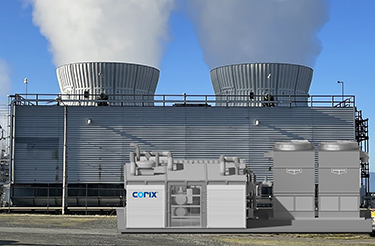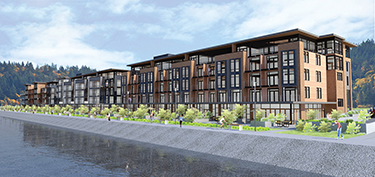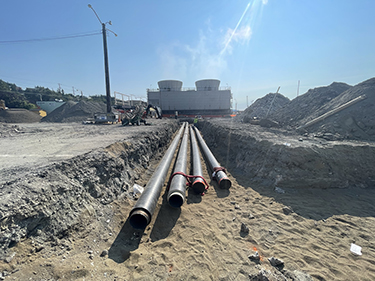|
Subscribe / Renew |
|
|
Contact Us |
|
| ► Subscribe to our Free Weekly Newsletter | |
| home | Welcome, sign in or click here to subscribe. | login |
Construction
| |
 |
March 28, 2024
Buried treasure: harnessing waste heat for a cleaner future
UMC

Locke
|
In neighborhoods around the world, a potent resource slips away unnoticed. This buried treasure is waste heat — a powerhouse for low-carbon energy that often remains untapped. Buildings, factories and other facilities vent, wash, or flush a wealth of energy into the air or down the drain. Now, leaders are harnessing it for low-carbon, energy-efficient heating and cooling.
WHERE DOES WASTE HEAT COME FROM?
Buildings are wasting heat everywhere, including industrial processes, energy production, mechanical equipment cooling, warm water and hot gases discharge, ventilation or building exhaust, municipal wastewater, and more. The quality of this waste heat varies with temperature, accessibility, economic viability for recovery, and the consistency of the supply. The higher the temperature, the more opportunities there are for re-use, but with today’s technology, even sources as cool as 60 degrees F still have heat to harvest.
WASTE HEAT RECOVERY TECHNOLOGIES
Various waste heat recovery technologies can harness untapped energy, offering major business opportunities for the construction industry to grow our communities sustainably. Not all of these innovations are new, but they are all constantly improving.
Heat exchangers facilitate the transfer of thermal energy between fluids at different temperatures. These come in all shapes and sizes and can be used to capture waste heat, repurposing it for use instead of losing it as heat pollution into the environment.
Heat pumps are the workhorse for today’s electric-powered heating and cooling. Heat pumps provide the unique opportunity to take a low-grade heat source and bump the temperature up or down to a point where it’s extremely useful for heating or cooling buildings.
Cogeneration systems, aka combined heat and power (CHP), simultaneously generate electricity and use the waste heat for heating or cooling purposes. Cogeneration maximizes the overall energy output from a single source.
Thermoelectric generators, like Organic Rankine Cycle, harness the principles of thermoelectricity. These generators convert temperature differentials into electrical power.
Once recovered, waste heat can be utilized promptly as either cool or warm air or water. Alternatively, the reclaimed heat can be preserved in thermal storage tanks for subsequent on-demand requirements.
These “thermal battery” systems stand out among other energy storage methods, boasting a 90-98% efficiency rate compared to 80-90% for utility-scale electric batteries. They even enjoy a lower cost to install and a longer lifespan. Remarkably recyclable, thermal energy doesn’t have to be “use it or lose it;” with smart insulation, you can keep generating, storing, converting and re-using the same thermal energy over and over.
Many heat sources ready for recovery are within easy reach. A building’s exhaust air streams (typically around 70 degrees) and facility wastewater (ranging from 50-70 degrees) are excellent waste heat sources for the rapidly improving heat pump technology.
Additionally, integrating heat recovery chillers with thermal storage offers an excellent solution for supplying cooling during daytime hours while storing excess waste heat for extended periods until required. This approach is especially valuable in environments requiring heating in the morning and cooling in the afternoon.
CLEAN ENERGY FOR OUR NEIGHBORS
Not far up the I-5 corridor from Seattle, the Port of Bellingham had a vision for redeveloping its downtown waterfront district, adding new life to the community and simultaneously reducing carbon pollution. Through a partnership between Corix and Port of Bellingham, UMC is working to help bring the vision to life with a new low-carbon district energy system that will turn waste heat into efficient heating and cooling for a neighborhood of approximately 1.6 million square feet of mixed-use development.
This ambitious project will put to work waste heat from PSE’s Encogen Generating Station located nearby and is the first to meet the 2021 Washington State Energy Code’s “low carbon district energy system” with some of the most stringent efficiency and performance requirements in North America.
Corix will capture waste heat from PSE’s cooling tower and return the water to a cooler temperature, further improving the efficiency of PSE’s steam turbine — a win-win for everyone. Not only cutting pollution, the system will be about four times more efficient than traditional heating systems. It can be scaled with additional capacity, ensuring equipment and capital are deployed as needed as the neighborhood thrives and grows. This extraordinary system goes live this spring.
“We’re thrilled to be part of this exciting project that supports the transition to clean energy in the State of Washington. District energy provides a platform to employ various low-carbon energy sources, including the beneficial reclamation of waste heat,” said Travis Hickford-Kulak, Senior Vice President at Corix. “By working toward a common goal of reducing greenhouse gas emissions, our system has the opportunity to grow and expand and impact the wellbeing of the entire community.”
WASTE HEAT REVOLUTION FOR CLIMATE SOLUTION
While waste heat recovery is not a new concept, new technologies are emerging to answer customer demands to meet new codes and policies, battle climate change, and keep up with the world’s ever-increasing energy demands. Many U.S. jurisdictions are proposing or have already implemented policies that reduce or ban fossil fuels in certain new and renovated buildings, both individually and in campus settings. When powered by low-carbon electricity, waste heat recovery and storage coupled with district thermal can efficiently and affordably create, use, store, and share sustainable heating and cooling.
In Washington State, policies driving building decarbonization include the Clean Buildings Standard for energy efficiency, energy codes curbing fossil fuels in the built environment, and municipal policies like the city of Seattle’s new Building Emissions Performance Standard. Some building codes are now specifically requiring heat recovery in high-rise residential buildings, with further codes on the way for heat recovery in commercial buildings. Combined with customer demand, these policy pushes are driving rapid progress in waste heat recovery in Washington.
Waste heat recovery systems with thermal energy storage help reduce overall energy requirements, lowering the stress on the larger electric grid and empowering buildings to integrate thermal storage for peak-shifting, demand response, and accelerating fossil fuel phaseout. That means affordable climate comfort, carbon responsibility, and resiliency for all — for the individual buildings involved, for their linked energy districts and the broader community.
Scott Locke is an associate principal and director in UMC’s Energy Services Group.
Other Stories:
- Centering equity, reconciliation and community in coastal adaptation
- Eastside cities partner for climate action
- Reclaiming our shores
- Five environmental factors influencing construction in 2024
- Floating wetlands strengthen urban ecosystems and community engagement
- A park for all people — and the environment
- Planning for a rainy day, every day





